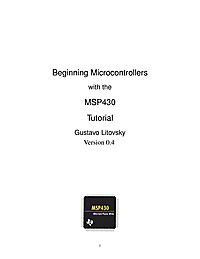Arduino Programming Notebook
This notebook serves as a convenient, easy to use programming reference for the command structure and basic syntax of the Arduino microcontroller. To keep it simple, certain exclusions were made that make this a beginner’s reference best used as a secondary source alongside other websites, books, workshops, or classes. This decision has lead to a slight emphasis on using the Arduino for standalone purposes and, for example, excludes the more complex uses of arrays or advanced forms of serial communication.

Introduction to Embedded Systems - A Cyber-Physical Systems Approach
This book strives to identify and introduce the durable intellectual ideas of embedded systems as a technology and as a subject of study. The emphasis is on modeling, design, and analysis of cyber-physical systems, which integrate computing, networking, and physical processes. This book is intended for students at the advanced undergraduate level or the introductory graduate level, and for practicing engineers and computer scientists who wish to understand the engineering principles of embedded systems.
High Performance Systems, Applications and Projects
This book addresses a wide spectrum of research topics of embedded systems, including parallel computing, communication architecture, application-specific systems, and embedded systems projects.

Lessons in Electric Circuits - Volume III - Semiconductor
This book covers all of the common semiconductor devices and their principles of operation. However, the true value of this reference is in the fact that it provides key circuits and applications where they come in handy. A few of the devices that are covered in this book are Bipolar junction transistors, diodes, JFETs, thyristors, OPAMPs and FETs. This book will be a good reference in your library that has a clear style of explanation.

Embedded Linux Primer
This book brings together indispensable knowledge for building efficient, high-value, Linux-based embedded products: information that has never been assembled in one place before. Drawing on years of experience as an embedded Linux consultant and field application engineer, Christopher Hallinan offers solutions for the specific technical issues you're most likely to face, demonstrates how to build an effective embedded Linux environment, and shows how to use it as productively as possible.

Introduction to Embedded Systems
This is the first chapter in the book Embedded Systems Hardware for Software Engineers.

Beginning Microcontrollers with the MSP430 - Tutorial
From the Preface: I decided to write this tutorial after seeing many students struggling with the concepts of programming the MSP430 and being unable to realize their applications and projects. This was not because the MSP430 is hard to program. On the contrary, it adopts many advances in computing that has allowed us to get our application running quicker than ever. However, it is sometimes difficult for students to translate the knowledge they acquired when studying programming for more traditional platforms to embedded systems.

Essential Linux Device Drivers
This book is about writing Linux device drivers. It covers the design and development of major device classes supported by the kernel, including those I missed during my Linux-on-Watch days. The discussion of each driver family starts by looking at the corresponding technology, moves on to develop a practical example, and ends by looking at relevant kernel source files. Before foraying into the world of device drivers, however, this book introduces you to the kernel and discusses the important features of 2.6 Linux, emphasizing those portions that are of special interest to device driver writers.

Introduction to Embedded Systems
This is the first chapter in the book Embedded Systems Hardware for Software Engineers.
Arduino Programming Notebook
This notebook serves as a convenient, easy to use programming reference for the command structure and basic syntax of the Arduino microcontroller. To keep it simple, certain exclusions were made that make this a beginner’s reference best used as a secondary source alongside other websites, books, workshops, or classes. This decision has lead to a slight emphasis on using the Arduino for standalone purposes and, for example, excludes the more complex uses of arrays or advanced forms of serial communication.

Red Hat Linux - The Complete Reference
This book identifies seven major Linux topics: basic setup, environments and applications, the Internet, servers, administration, and network administration. These topics are integrated into the different ways Red Hat presents its distribution: as a desktop workstation, network workstation, server, and development platform
High Performance Systems, Applications and Projects
This book addresses a wide spectrum of research topics of embedded systems, including parallel computing, communication architecture, application-specific systems, and embedded systems projects.

Lessons in Electric Circuits - Volume III - Semiconductor
This book covers all of the common semiconductor devices and their principles of operation. However, the true value of this reference is in the fact that it provides key circuits and applications where they come in handy. A few of the devices that are covered in this book are Bipolar junction transistors, diodes, JFETs, thyristors, OPAMPs and FETs. This book will be a good reference in your library that has a clear style of explanation.

Embedded Linux Primer
This book brings together indispensable knowledge for building efficient, high-value, Linux-based embedded products: information that has never been assembled in one place before. Drawing on years of experience as an embedded Linux consultant and field application engineer, Christopher Hallinan offers solutions for the specific technical issues you're most likely to face, demonstrates how to build an effective embedded Linux environment, and shows how to use it as productively as possible.

















